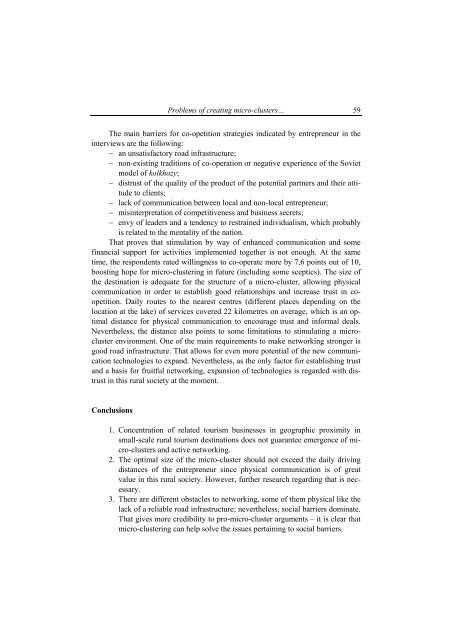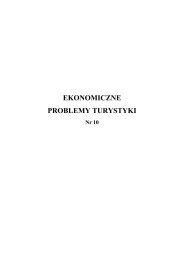Zeszyt naukowy - caÅoÅÄ - WydziaÅ ZarzÄ dzania i Ekonomiki UsÅug
Zeszyt naukowy - caÅoÅÄ - WydziaÅ ZarzÄ dzania i Ekonomiki UsÅug
Zeszyt naukowy - caÅoÅÄ - WydziaÅ ZarzÄ dzania i Ekonomiki UsÅug
You also want an ePaper? Increase the reach of your titles
YUMPU automatically turns print PDFs into web optimized ePapers that Google loves.
Problems of creating micro-clusters… 59<br />
The main barriers for co-opetition strategies indicated by entrepreneur in the<br />
interviews are the following:<br />
an unsatisfactory road infrastructure;<br />
non-existing traditions of co-operation or negative experience of the Soviet<br />
model of kolkhozy;<br />
distrust of the quality of the product of the potential partners and their attitude<br />
to clients;<br />
lack of communication between local and non-local entrepreneur;<br />
misinterpretation of competitiveness and business secrets;<br />
envy of leaders and a tendency to restrained individualism, which probably<br />
is related to the mentality of the nation.<br />
That proves that stimulation by way of enhanced communication and some<br />
financial support for activities implemented together is not enough. At the same<br />
time, the respondents rated willingness to co-operate more by 7,6 points out of 10,<br />
boosting hope for micro-clustering in future (including some sceptics). The size of<br />
the destination is adequate for the structure of a micro-cluster, allowing physical<br />
communication in order to establish good relationships and increase trust in coopetition.<br />
Daily routes to the nearest centres (different places depending on the<br />
location at the lake) of services covered 22 kilometres on average, which is an optimal<br />
distance for physical communication to encourage trust and informal deals.<br />
Nevertheless, the distance also points to some limitations to stimulating a microcluster<br />
environment. One of the main requirements to make networking stronger is<br />
good road infrastructure. That allows for even more potential of the new communication<br />
technologies to expand. Nevertheless, as the only factor for establishing trust<br />
and a basis for fruitful networking, expansion of technologies is regarded with distrust<br />
in this rural society at the moment.<br />
Conclusions<br />
1. Concentration of related tourism businesses in geographic proximity in<br />
small-scale rural tourism destinations does not guarantee emergence of micro-clusters<br />
and active networking.<br />
2. The optimal size of the micro-cluster should not exceed the daily driving<br />
distances of the entrepreneur since physical communication is of great<br />
value in this rural society. However, further research regarding that is necessary.<br />
3. There are different obstacles to networking, some of them physical like the<br />
lack of a reliable road infrastructure; nevertheless, social barriers dominate.<br />
That gives more credibility to pro-micro-cluster arguments – it is clear that<br />
micro-clustering can help solve the issues pertaining to social barriers.

















